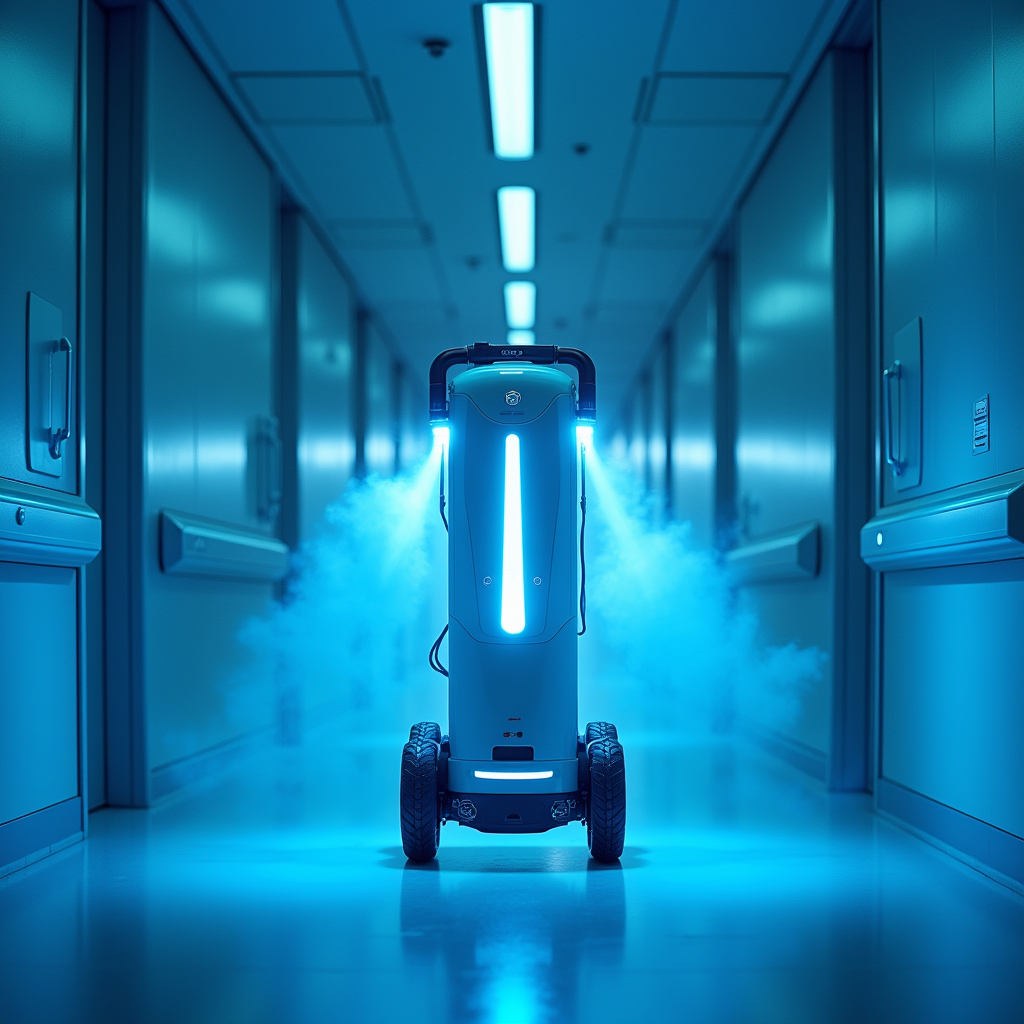This article has been written by Sathiyabama pursuing a Training program on Using AI for Business Growth course from Skill Arbitrage.
This article has been edited and published by Shashwat Kaushik.
Table of Contents
Introduction
Our world embarks on a new journey with the launch of robots in every field. In the initial stage, robots are designed mainly to reduce costs and human power and are mostly used in industries. But now, robots are engaged in domestic work, sports, healthcare, mining, films, and also the nuclear industry, in which humans are at risk. In the realm of domestic work, robots are increasingly becoming indispensable assistants, performing a wide range of tasks from cleaning and cooking to laundry and yard work. This not only alleviates the burden of household chores but also enables individuals to focus on more fulfilling pursuits.
Healthcare is another area where robots are making a profound impact. Surgical robots offer greater precision and control, enabling minimally invasive procedures and faster patient recovery times. Exoskeletons and other assistive devices empower individuals with disabilities to regain mobility and independence.
In the mining industry, robots are being deployed in hazardous environments, such as deep mines and unstable terrains, to perform tasks that would be too dangerous or impractical for human workers. This not only enhances safety but also increases productivity and efficiency. The film industry has also embraced robotics, with robots being used for everything from stunt work and special effects to motion capture and animation. This technological integration has opened up new possibilities for cinematic storytelling and visual artistry. Even in the nuclear industry, where human presence poses significant risks, robots are playing a vital role. They are employed for decommissioning tasks, waste management, and radiation monitoring, ensuring the safety of workers and the environment. Let’s check out how robots are used in hazardous material handling and disposal.
Understanding hazardous material
Hazardous materials, also called HAZMAT, can be solid, liquid or gaseous substances that pose a risk to people’s health and environment. It exhibits characteristics of corrosion, explosion, ignitability and reactivity. It includes toxic metals, toxic chemicals, fuel, nuclear waste, radioactive waste and certain biological substances.
❖ Toxic Metals: Mercury, Lead, Chromium, Arsenic
❖ Chemicals: Acids, pesticides, solvent-based paints
❖ Fuels: Petrol and Kerosene
❖ Nuclear/Radioactive waste: Uranium, Isotopes, Tritium H3
❖ BioHazards: Viruses, Bacteria, Fungi, Toxins
These HAZMAT substances may lead to cancer, respiratory issues, vomiting, and nausea while inhaling or swallowing them. If it is disposed of on land or in water directly, it will result in water pollution or environmental risks like diseases, contamination of underground water, and polluting air.
Robots for handling and disposal of hazardous material
Robots for handling and disposal of hazardous material play a vital role in ensuring the safety of workers and the environment. These robots are specially designed to operate in hazardous environments, reducing the risk of human exposure to dangerous substances.
One of the key applications of these robots is in the handling of radioactive materials. These materials, often found in nuclear power plants and research facilities, pose a significant risk to human health. Robots can be equipped with specialised shielding and remote control systems to safely handle radioactive materials, reducing the risk of contamination and exposure.
Another critical area where robots are employed is in the disposal of hazardous waste. Chemical spills, industrial accidents, and natural disasters can result in the release of toxic substances into the environment. Robots can be used to collect, transport, and dispose of these materials in a safe and controlled manner.
Robots for handling and disposal of hazardous material are equipped with a range of advanced features that enable them to operate effectively in challenging environments. These features include:
- Remote control systems: Robots can be controlled remotely from a safe distance, allowing operators to avoid direct exposure to hazardous materials.
- Specialised sensors: Robots are equipped with sensors that can detect and measure radiation, chemical vapours, and other hazardous substances. This information can be used to make informed decisions about how to handle and dispose of the materials.
- Manipulators and grippers: Robots are often equipped with robotic arms and grippers that allow them to manipulate and grasp objects with precision. This capability is essential for handling delicate or dangerous materials.
- Rugged construction: Robots for handling and disposal of hazardous material are built with rugged materials and construction to withstand harsh environments and ensure reliable performance.

These robots have proven invaluable in various industries, including nuclear power, chemical manufacturing, and environmental cleanup. By automating the handling and disposal of hazardous materials, robots help protect workers and the environment from potential harm.
As technology advances, we can expect to see even more sophisticated robots designed for the handling and disposal of hazardous materials. These robots will be equipped with artificial intelligence, machine learning, and advanced sensor technology, enabling them to operate autonomously and make complex decisions in real-time. This will further enhance their capabilities and effectiveness in keeping workers and the environment safe.
Let us see how robots help us in handling and disposing of hazardous materials. Some of the robots that handle and dispose of hazardous materials are mentioned below.
| Hazardous material | Autonomous robots for disposal |
| Bombs | DRDO Daksh |
| Uranium | Microbots |
| Pathogens | UVC Disinfection Robots |
| Paint | Laser Coat Removal Robot |
| Dyeing | iCone Robot |
| Lead | Graphene Oxide based Microbots |
Applications of autonomous robots in hazardous material handling
DRDO Daksh – Military- Daksh, a robot to destroy bombs
- Daksh is a battery-operated, remote-controlled robot created by the Defence Research and Development Organisation (DRDO), India, to identify, locate and destroy hazardous materials like bombs.
- It comes with four wheels, an arm and a shotgun. The wheels make it easy to navigate and locate bombs.
- The arm is used to lift any objects and scan for bombs using a portable X-ray device and destroy them with a water jet disrupter.
- The shotgun breaks locked doors and scans for bombs.
Microbots
- Microbots are tiny, nanosized, self-propelled particles created by the American Chemical Society (ACS) to capture, separate and remove hazardous substances like uranium from nuclear wastewater.
- The wastewater generated in the nuclear reactor contains uranium and isotopes, which are toxic in nature.
Microbots are remarkable substances composed of a micromotor attached to a rod-shaped metal-organic framework nanoparticle known as ZIF-8. Iron atoms and iron oxide are strategically incorporated into the structure to enhance stability and impart magnetic properties to these microbots.
Once introduced into wastewater, microbots undergo a captivating process. They interact with hydrogen peroxide present in the wastewater, triggering a fascinating reaction. The hydrogen peroxide is converted into oxygen bubbles, which serve as the propulsion mechanism for the microbots. The microbots harness the energy released from this reaction to propel themselves at an astonishing speed that is 60 times their own length per second. This exceptional movement allows them to navigate and explore the wastewater effectively.
After the wastewater treatment process is complete, the microbots are skilfully retrieved from the wastewater using a magnet. This magnetic retrieval process leverages the iron oxide component integrated into the microbots. Once retrieved, the microbots undergo a crucial step where the uranium that has been captured during the wastewater treatment process is stripped off. This step ensures that the microbots are free from any residual contaminants before they are sent for recycling.
The recycling process for microbots is designed to recover and reuse valuable materials. It involves breaking down the microbots into their constituent components, which can then be repurposed for future applications. This recycling process promotes sustainability and reduces the environmental impact associated with the manufacturing of new microbots.
The combined efforts of hydrogen peroxide conversion, magnetic retrieval, uranium stripping, and recycling contribute to the remarkable efficiency and eco-friendliness of microbots in wastewater treatment. Their ability to propel themselves, selectively capture uranium, and undergo recycling processes showcases their potential as innovative and environmentally conscious solutions for wastewater management.
DJI Drones with FlytBase Dashboard- Drone for disaster management
- Drones are flying objects with cameras that fly around any area of risk and collect visual data for interpretation.
- DJI drones are drones with sensors that can collect information regarding chemicals, vapour and radiation in the hazardous area once they fly around it.
- DJI Drones with Flytbase Dashboard is a web panel connected with multiple drones to control and manage drones over a network that helps in accurate visual detection of the entire hazardous area.
- Using this Flytbase Dashboard, drones can be programmed to do a perimeter check and provide vital situational information.
- Drones can provide the live video feed to HAZMAT experts so that they can find the exact source of any hazard. (For example, gas leak, etc.)
- It is better at calculating risks in real time than the man in the HAZMAT suit.

Pipeline Robots-A6 Optical Methane Detector Robot
- The leakage of natural gas in underground pipelines that have been placed to extract methane gas will result in an explosion.
- If the gas is consumed by people or animals, it causes severe skin problems, lung disease, cancer, and, in some cases, it may lead to death.
- The robots serve as a platform for sensors and repair technology that can adapt to each situation.
- It can provide precise results by moving along the surface of an underground pipeline to scan for any leaks in the pipe.
- Several spray liners, structural lining and sealants can be used to make repairs. The robot can also operate in a pressurised environment.
UV-C Disinfection Robots: UV-C Disinfection Robots with sensors and UVC lamps
- The UV-C Disinfection Robots are used in surface decontamination in the cleaning process.
- Manual cleaning requires more time and skilled staff who should be aware of how to use radiation for disinfection.
- This is where disinfection robots step in to kill microorganisms like viruses and bacteria in the hospital by UV light.
- It has wheels to move and different types of sensors that detect temperature, humidity, obstacles and moving objects in its pathway.
- It goes around the hospital and senses the presence of any microorganisms and kills them by UV radiation.
Laser Coating Removal Robots- A laser coat removal robot to remove old paint
- In the field of aviation, aircraft need to be stripped and recoated as a part of maintenance.
- Removing the paint involves soaking airframes with large amounts of solvents followed by hands-on scrubbing by technicians, which can pose health hazards to personnel and create a significant environmental impact.
- This LCR robot removes paint by passing a laser to the aircraft surface, which collects the paint particles.
- It provides 60% more efficiency than the traditional depainting process.
- It can also eliminate the need for storage, handling, and disposal of chemical solvents used in traditional methods, saving costs and people from environmental hazards.
- In a similar way, automated paint robots paint the aircraft with accuracy rather than traditional spray gun methods.
iCone Robots: iCone machines in which the liquor flows in both directions, inside out and outside in
- Dyeing is a very complex process that requires dips of textiles in a dyeing bath at the correct temperature and liquor ratio.
- It has been carried out by hand in most of the factories.
- Even preparing a dyeing bath, which is a mixture of different chemicals, is carried out by hands and poses a great risk to human health.
- iCone Robots, introduced in 2014, brings a solution to this problem.
- The dye silos receive a signal from the control system, which might order (e.g., dispense 30 grammes each of red, yellow, and blue dyes).
- Upon receiving this signal, the dyes are automatically weighed, dispensed into a container and transported to a dye dissolving station.
- Here, the dye is brought to the required temperature and then runs into the dyeing machine at the correct time.
- By using these robots, high levels of colour authenticity have been achieved.
Mining Robots: A movable drilling robot
- Mining robots are used to drill holes in mines for blasting or exploration.
- Gold, diamonds, platinum, and some rare minerals are extracted in underground mines by hauling, drilling, and exploration processes.
- This environment is dangerous to humans due to the risk of explosions, poisonous gases, mine collapses, etc.
- These mining robots come with sensors to detect hazardous gases, unstable rock structures and some other dangers that may not be visible to the human eye.
Graphene Oxide-based Microbots
- It helps in removing lead, a toxic metal present in industrial wastewater.
- Microbots structure consists of nanosized multilayers of graphene oxide, nickel, and platinum, providing different functionalities.
- The outer layer of graphene oxide captures lead on the surface, and the inner layer of platinum functions as the engine decomposing hydrogen peroxide fuel for self-propulsion, while the middle layer of nickel enables external magnetic control of the microbots.
- GOx microbots effectively remove lead 10 times better than non-GOx microbots.

Benefits of using autonomous robots
- Increased accuracy: Autonomous robots can perform tasks with a high degree of precision and accuracy, minimising errors and reducing the potential for mistakes. This is especially important in industries such as manufacturing, healthcare, and logistics, where even minor deviations can have significant consequences.
- Higher productivity: Autonomous robots can work 24/7 without breaks, increasing overall productivity and efficiency. They can handle repetitive tasks quickly and consistently, freeing up human workers to focus on more complex and creative activities.
- Reliability: Autonomous robots are designed to operate with minimal downtime, ensuring reliable and consistent performance. They are not subject to fatigue, distractions, or other human factors that can impact productivity and accuracy.
- Flexibility: Autonomous robots can be programmed to perform a wide range of tasks and adapt to changing requirements. This flexibility allows them to handle different tasks and applications without the need for extensive reprogramming or modifications.
- Safe working environment: Autonomous robots can take on dangerous or hazardous tasks, reducing the risk of workplace accidents and injuries. This is particularly beneficial in industries such as mining, construction, and chemical processing, where human workers are exposed to potential hazards.
- Reducing Workplace Accidents: By automating hazardous tasks, autonomous robots can help reduce the number of workplace accidents and injuries. This can lead to improved safety records and lower insurance premiums for businesses.
- Enhanced efficiency: Autonomous robots can optimise processes and workflows by identifying inefficiencies and suggesting improvements. They can also collect and analyse data to provide insights into operations, allowing for more informed decision-making.
- Cost-effectiveness: While the initial investment in autonomous robots may be significant, the long-term cost savings can be substantial. Autonomous robots can operate with lower energy consumption, require less maintenance, and have a longer lifespan compared to traditional equipment.
- Easy to integrate and replace: Autonomous robots are designed to be easy to integrate into existing systems and processes. They can be deployed quickly and efficiently, with minimal disruption to operations. Additionally, they can be easily replaced or upgraded as technology advances, ensuring that businesses stay competitive.
These robots help people by detecting anomalies and figuring out a solution to prevent or destroy them. By integrating robots in their respective fields, we can have a chance to live in a healthy and safe workplace with increased productivity.
Conclusion
The robots lend their hand in making our environment clean and safe. They not only perform tasks efficiently but also protect people from hazardous environments. As cutting-edge technology, robotics has immense potential for HAZMAT response and is quickly becoming an integral part of the standard response in many countries. These robots now become a part of all the HAZMAT operations by collecting, analysing and interpreting the situation with their machine vision cameras, senses risk using sensors and also, using its advanced mechanics it finds a way to solve it or alerts the appropriate team.
References
- https://www.slideshare.net/slideshow/industrial-waste-management-72995701/72995701
- https://ehs.research.uiowa.edu/list-hazardous-materials-and-disposal-contacts
- https://www.linkedin.com/pulse/decoding-hazardous-environment-waste-handling-robots-umgie?utm_campaign=2&utm_medium=cp_309&utm_source=Linkedin&utm_content=ia&utm_term=factory-automation-and-machine-vision&utm_id=free
- Industry Insights: Chemical and Hazardous Material Handling Robotics | Robotic Industries Association (automate.org)
- https://www.slideshare.net/RambabuPalaka/hazardous-waste-management-121216869
- https://www.sciencedaily.com/releases/2019/10/191030120306.htm#:~:text=Now%2C%20researchers%20have%20developed%20tiny,radioactive%20uranium%20from%20simulated%20wastewater.&text=FULL%20STORY-,According%20to%20some%20experts%2C%20nuclear%20power%20holds%20great%20promise%20for,demands%20without%20generating%20greenhouse%20gases.
- https://www.theengineer.co.uk/content/news/robots-in-the-pipeline-to-reduce-water-leas
- https://sustainability.asianpaints.com/sustainability/environment-nature-positive.php#:~:text=We%20directed%209%25%20of%20hazardous,waste%20was%20directed%20for%20recycling.&text=Industrial%20effluent%20is%20generated%20during,during%20equipment%20and%20pipeline%20cleaning.
- https://www.automate.org/robotics/industry-insights/chemical-and-hazardous-material-handling-robotics#:~:text=These%20robots%20are%20in%20work,like%20viruses%20or%20other%20pathogens.
- https://www.tandfonline.com/doi/abs/10.1080/00207230008711308
- https://cpcb.nic.in/hazardous-waste-rules/
- https://www.eolss.net/sample-chapters/c09/e1-08-06.pdf
 Serato DJ Crack 2025Serato DJ PRO Crack
Serato DJ Crack 2025Serato DJ PRO Crack










 Allow notifications
Allow notifications



